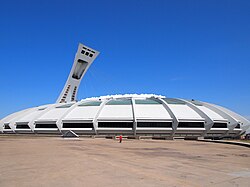
Back ملعب مونتريال الأولمبي Arabic Estadi Olímpic de Montreal Catalan Olympijský stadion (Montréal) Czech Olympiastadion Montreal German Ολυμπιακό Στάδιο του Μόντρεαλ Greek Olimpika Stadiono de Montrealo Esperanto Estadio Olímpico de Montreal Spanish ورزشگاه المپیک مونترآل Persian Montrealin olympiastadion Finnish Stade olympique de Montréal French
| Stade olympique | |
The Big O | |
 | |
| Address | 4545 Pierre-de-Coubertin Avenue |
|---|---|
| Location | Montreal, Quebec, Canada |
| Coordinates | 45°33′29″N 73°33′07″W / 45.558°N 73.552°W |
| Public transit | |
| Owner | Régie des Installations Olympiques (Government of Quebec) |
| Capacity | Permanent capacity: 56,040 (1992–present)[1] 1976 Summer Olympics: 73,000 (1976–1992) Baseball: 49,757 (1992–present)[2] Soccer: 61,004[3] Football: 66,308[4] |
| Record attendance | 78,322 (Pink Floyd, July 6, 1977) |
| Field size | Foul Lines: 99 metres (325 ft) (1977), 101 metres (330 ft) (1981), 99 metres (325 ft) (1983) Power Alleys: 114 metres (375 ft) Centre Field: 123 metres (404 ft) (1977), 123 metres (405 ft) (1979), 123 metres (404 ft) (1980), 122 metres (400 ft) (1981), 123 metres (404 ft) (1983) Backstop: 19 metres (62 ft) (1977), 20 metres (65 ft) (1983), 16 metres (53 ft) (1989) |
| Surface | Grass (1976 and June 2, 2010) AstroTurf (1977–2001, 2005–06) Defargo Astrograss (2002–03) FieldTurf (2003–2005) Team Pro EF RD (2007–2014) Xtreme Turf by Act Global (2014–2022) FIFA Quality Pro (2023–)[5] |
| Construction | |
| Broke ground | April 28, 1973 |
| Opened | July 17, 1976 April 15, 1977 (baseball) |
| Construction cost | C$ 770 million C$ 5.2 billion[6] (2017 – including additional costs, interest and repairs for the entire Olympic Park) |
| Architect | Roger Taillibert[7] |
| Tenants | |
| Montreal Expos (MLB) (1977–2004) Montreal Alouettes/Concordes (CFL) (1976–86, 1996–97, part-time 1998–2013) Montreal Manic (NASL) (1981–83) Montreal Machine (WLAF) (1991–92) CF Montréal (MLS) (2012–present, select games) | |
| Website | |
Parc Olympique Website
 | |
Olympic Stadium[1] (French: Stade olympique, pronounced [stad ɔlɛ̃pik]) is a multi-purpose stadium in Montreal, Canada, located at Olympic Park in the Hochelaga-Maisonneuve district of the city. Built in the mid-1970s as the main venue for the 1976 Summer Olympics, it is nicknamed "The Big O", a reference to both its name and to the doughnut-shape of the permanent component of the stadium's roof. It is also disparagingly referred to as "The Big Owe" in reference to the high cost of its construction and of hosting the 1976 Olympics as a whole.[8]
The stadium is one of the largest by seating capacity in Canada. After the Olympics, artificial turf was installed and it became the home of Montreal's professional baseball and football teams. The Montreal Alouettes of the CFL returned to their previous home of Molson Stadium in 1998 for regular season games, but continued to use Olympic Stadium for playoff and Grey Cup games until 2012. Following the 2004 baseball season, the Expos relocated to Washington, D.C., to become the Washington Nationals. The stadium currently serves as a multipurpose facility for special events (e.g. concerts, trade shows) with a permanent seating capacity of 56,040.[1] The capacity is expandable with temporary seating. CF Montréal (formerly known as Montreal Impact) of Major League Soccer (MLS) has used the venue when demand for tickets justifies the large capacity or when the weather restricts outdoor play at nearby Saputo Stadium in the spring months.
The stadium has not had a main tenant since the Expos left in 2004. Despite decades of use, the stadium's history of numerous structural and financial problems has largely branded it a white elephant.
Incorporated into the north base of the stadium, inclined at 45°, and not completed until a full decade after the stadium's opening, is the Montreal Tower. At 165 metres (541 ft) it is the world's tallest inclined tower. The stadium and Olympic Park grounds border Maisonneuve Park, which includes the Montreal Botanical Garden, adjacent to the west across Sherbrooke Street (Route 138).
- ^ a b c "The Stadium". Parc olympique. Archived from the original on October 7, 2022. Retrieved May 12, 2018.
- ^ MLB commissioner says Montreal needs a firm commitment for new stadium Archived October 24, 2016, at the Wayback Machine. The Globe and Mail. April 1, 2015. Retrieved April 28, 2015
- ^ "Approximately 2,000 additional tickets on sale at noon". Montreal Impact. Archived from the original on September 24, 2015. Retrieved June 22, 2015.
- ^ Stamps spoil party in Montreal with big 'W' at 'Big O' Archived October 15, 2012, at the Wayback Machine. cfl.ca. Retrieved April 28, 2015
- ^ "Une nouvelle surface de jeu au Stade olympique". Archived from the original on February 20, 2023. Retrieved February 20, 2023.
- ^ "The true value of Montreal's Olympic Park". September 20, 2018.
- ^ Cite error: The named reference
boatdrswas invoked but never defined (see the help page). - ^ Cite error: The named reference
CBC-StadiumDebtPaidwas invoked but never defined (see the help page).


